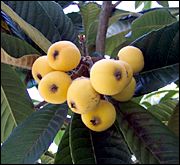Whether you accept it, avoid it or live somewhere in between, insurance coverage has become a defining issue for our profession. Patients increasingly expect to use their benefits, practitioners want to be compensated fairly for their time and expertise, and the system itself remains – at best – fragmented. The encouraging news is that coverage has expanded in meaningful ways. The challenging news is that reimbursement, across the board, remains inadequate.
Herbs & Botanicals
Loquat Leaf (pi pa ye)
What is loquat leaf? What is it used for?
Loquat is a type of fruit tree that grows in the tropics and subtropics. Similar to an evergreen tree in appearance, the loquat produces round fruits that resemble pairs, and range in color from white to orange. Loquat fruits are considered a delicacy in some Asian nations.
For medicinal purposes, however, the leaf of the loquat tree is used. The leaves are gathered in late spring and early summer and dried in the sun. After drying, the soft external hairs, or down, of the leaves are brushed off, and the leaves are cut into small pieces.
 In traditional Chinese medicine, loquat leaf is considered bitter and cool, and is associated with the Lung and Stomach meridians. Its functions are to transform phlegm, clear lung heat, and harmonize the stomach. Among the conditions treated by loquat leaf are nausea, vomiting, belching, hiccups, and gastrointestinal distress. It also helps to stop bleeding. Loquat leaf can also be used as part of a poultice to treat skin conditions such as eczema and skin ulcers.
In traditional Chinese medicine, loquat leaf is considered bitter and cool, and is associated with the Lung and Stomach meridians. Its functions are to transform phlegm, clear lung heat, and harmonize the stomach. Among the conditions treated by loquat leaf are nausea, vomiting, belching, hiccups, and gastrointestinal distress. It also helps to stop bleeding. Loquat leaf can also be used as part of a poultice to treat skin conditions such as eczema and skin ulcers.
How much loquat leaf should I take?
The typical dosage of loquat leaf is 4.5 to 12 grams of dried leaf, boiled in water and taken as a tea or decoction. Larger amounts (15 to 30 grams) can be used if the leaves are fresh.
What forms of loquat leaf are available?
Dried, chopped loquat leaf can be found at some Asian markets and specialty stores. Fresh loquat leaf - and fruit - may be found in Hawaii, California and states along the Gulf of Mexico where loquat is grown locally.
What can happen if I take too much loquat leaf? Are there any interactions I should be aware of? What precautions should I take?
The American Herbal Products Association has given loquat a class 2D rating, meaning that it should not be used long-term and that patients should not exceed the maximum recommended dosage. The downy hairs found in the surface of loquat leaf may irritate the mucus membranes; as such, patients taking loquat should ensure that the product they are using has been processed properly. As of this writing, there are no known drug interactions associated with loquat leaf. As always, make sure to consult with a licensed health care provider before taking loquat leaf or any other herbal remedy or dietary supplement.
References
- Chachin K, Hamauzu Y. Loquat. In: Mitra S, ed. Postharvest Physiology and Storage of Tropical and Subtropical Fruits. Wallingford, UK: CAB International, 1997, pp. 397-403.
- Ding CK, Chachin K, Hamauzu Y, et al. Effects of storage temperatures on physiology and quality of loquat fruit. Postharv Biol Technol 1998;14:309-315.
- McGuffin M, Hobbs C, Upton R, et al. (eds.) American Herbal Products Association's Botanical Safety Handbook. Boca Raton, FL: CRC Press, 1997, p. 48.
- Morton J. Fruits of Warm Climates. Miami: Florida Flair Books, 1987, pp. 103-108.
- Shinbori F, Nakai S. Qualitative changes during maturation and keeping qualities of loquat fruits. J Jap Soc Hort Sci 1991;60(Supl 2):590-591.


